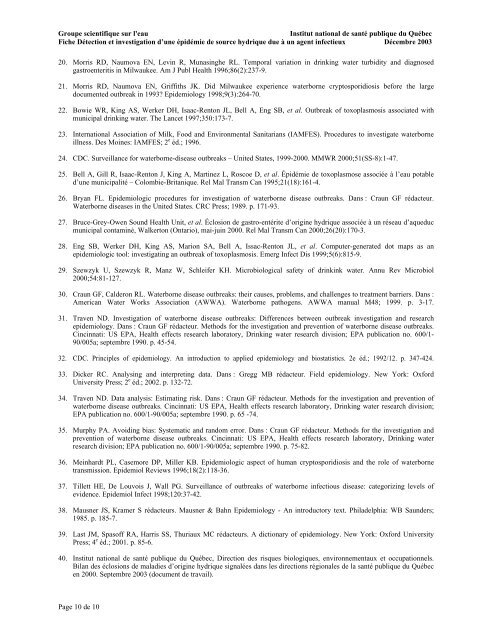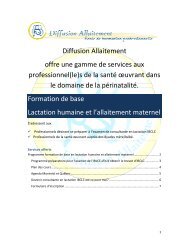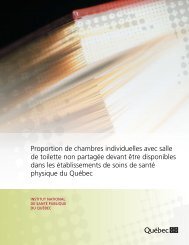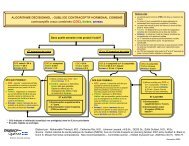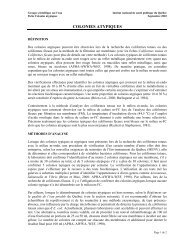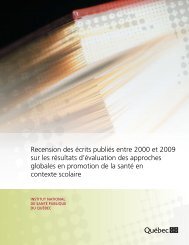Fiches synthèses sur l'eau potable et la santé humaine
Fiches synthèses sur l'eau potable et la santé humaine
Fiches synthèses sur l'eau potable et la santé humaine
You also want an ePaper? Increase the reach of your titles
YUMPU automatically turns print PDFs into web optimized ePapers that Google loves.
Groupe scientifique <strong>sur</strong> <strong>l'eau</strong> Institut national de <strong>santé</strong> publique du Québec<br />
Fiche Détection <strong>et</strong> investigation d’une épidémie de source hydrique due à un agent infectieux Décembre 2003<br />
20. Morris RD, Naumova EN, Levin R, Munasinghe RL. Temporal variation in drinking water turbidity and diagnosed<br />
gastroenteritis in Milwaukee. Am J Publ Health 1996;86(2):237-9.<br />
21. Morris RD, Naumova EN, Griffiths JK. Did Milwaukee experience waterborne cryptosporidiosis before the <strong>la</strong>rge<br />
documented outbreak in 1993? Epidemiology 1998;9(3):264-70.<br />
22. Bowie WR, King AS, Werker DH, Isaac-Renton JL, Bell A, Eng SB, <strong>et</strong> al. Outbreak of toxop<strong>la</strong>smosis associated with<br />
municipal drinking water. The Lanc<strong>et</strong> 1997;350:173-7.<br />
23. International Association of Milk, Food and Environmental Sanitarians (IAMFES). Procedures to investigate waterborne<br />
illness. Des Moines: IAMFES; 2 e éd.; 1996.<br />
24. CDC. Surveil<strong>la</strong>nce for waterborne-disease outbreaks – United States, 1999-2000. MMWR 2000;51(SS-8):1-47.<br />
25. Bell A, Gill R, Isaac-Renton J, King A, Martinez L, Roscoe D, <strong>et</strong> al. Épidémie de toxop<strong>la</strong>smose associée à l’eau <strong>potable</strong><br />
d’une municipalité – Colombie-Britanique. Rel Mal Transm Can 1995;21(18):161-4.<br />
26. Bryan FL. Epidemiologic procedures for investigation of waterborne disease outbreaks. Dans : Craun GF rédacteur.<br />
Waterborne diseases in the United States. CRC Press; 1989. p. 171-93.<br />
27. Bruce-Grey-Owen Sound Health Unit, <strong>et</strong> al. Éclosion de gastro-entérite d’origine hydrique associée à un réseau d’aqueduc<br />
municipal contaminé, Walkerton (Ontario), mai-juin 2000. Rel Mal Transm Can 2000;26(20):170-3.<br />
28. Eng SB, Werker DH, King AS, Marion SA, Bell A, Issac-Renton JL, <strong>et</strong> al. Computer-generated dot maps as an<br />
epidemiologic tool: investigating an outbreak of toxop<strong>la</strong>smosis. Emerg Infect Dis 1999;5(6):815-9.<br />
29. Szewzyk U, Szewzyk R, Manz W, Schleifer KH. Microbiological saf<strong>et</strong>y of drinkink water. Annu Rev Microbiol<br />
2000;54:81-127.<br />
30. Craun GF, Calderon RL. Waterborne disease outbreaks: their causes, problems, and challenges to treatment barriers. Dans :<br />
American Water Works Association (AWWA). Waterborne pathogens. AWWA manual M48; 1999. p. 3-17.<br />
31. Traven ND. Investigation of waterborne disease outbreaks: Differences b<strong>et</strong>ween outbreak investigation and research<br />
epidemiology. Dans : Craun GF rédacteur. M<strong>et</strong>hods for the investigation and prevention of waterborne disease outbreaks.<br />
Cincinnati: US EPA, Health effects research <strong>la</strong>boratory, Drinking water research division; EPA publication no. 600/1-<br />
90/005a; septembre 1990. p. 45-54.<br />
32. CDC. Principles of epidemiology. An introduction to applied epidemiology and biostatistics. 2e éd.; 1992/12. p. 347-424.<br />
33. Dicker RC. Analysing and interpr<strong>et</strong>ing data. Dans : Gregg MB rédacteur. Field epidemiology. New York: Oxford<br />
University Press; 2 e éd.; 2002. p. 132-72.<br />
34. Traven ND. Data analysis: Estimating risk. Dans : Craun GF rédacteur. M<strong>et</strong>hods for the investigation and prevention of<br />
waterborne disease outbreaks. Cincinnati: US EPA, Health effects research <strong>la</strong>boratory, Drinking water research division;<br />
EPA publication no. 600/1-90/005a; septembre 1990. p. 65 -74.<br />
35. Murphy PA. Avoiding bias: Systematic and random error. Dans : Craun GF rédacteur. M<strong>et</strong>hods for the investigation and<br />
prevention of waterborne disease outbreaks. Cincinnati: US EPA, Health effects research <strong>la</strong>boratory, Drinking water<br />
research division; EPA publication no. 600/1-90/005a; septembre 1990. p. 75-82.<br />
36. Meinhardt PL, Casemore DP, Miller KB. Epidemiologic aspect of human cryptosporidiosis and the role of waterborne<br />
transmission. Epidemiol Reviews 1996;18(2):118-36.<br />
37. Till<strong>et</strong>t HE, De Louvois J, Wall PG. Surveil<strong>la</strong>nce of outbreaks of waterborne infectious disease: categorizing levels of<br />
evidence. Epidemiol Infect 1998;120:37-42.<br />
38. Mausner JS, Kramer S rédacteurs. Mausner & Bahn Epidemiology - An introductory text. Phi<strong>la</strong>delphia: WB Saunders;<br />
1985. p. 185-7.<br />
39. Last JM, Spasoff RA, Harris SS, Thuriaux MC rédacteurs. A dictionary of epidemiology. New York: Oxford University<br />
Press; 4 e éd.; 2001. p. 85-6.<br />
40. Institut national de <strong>santé</strong> publique du Québec, Direction des risques biologiques, environnementaux <strong>et</strong> occupationnels.<br />
Bi<strong>la</strong>n des éclosions de ma<strong>la</strong>dies d’origine hydrique signalées dans les directions régionales de <strong>la</strong> <strong>santé</strong> publique du Québec<br />
en 2000. Septembre 2003 (document de travail).<br />
Page 10 de 10


